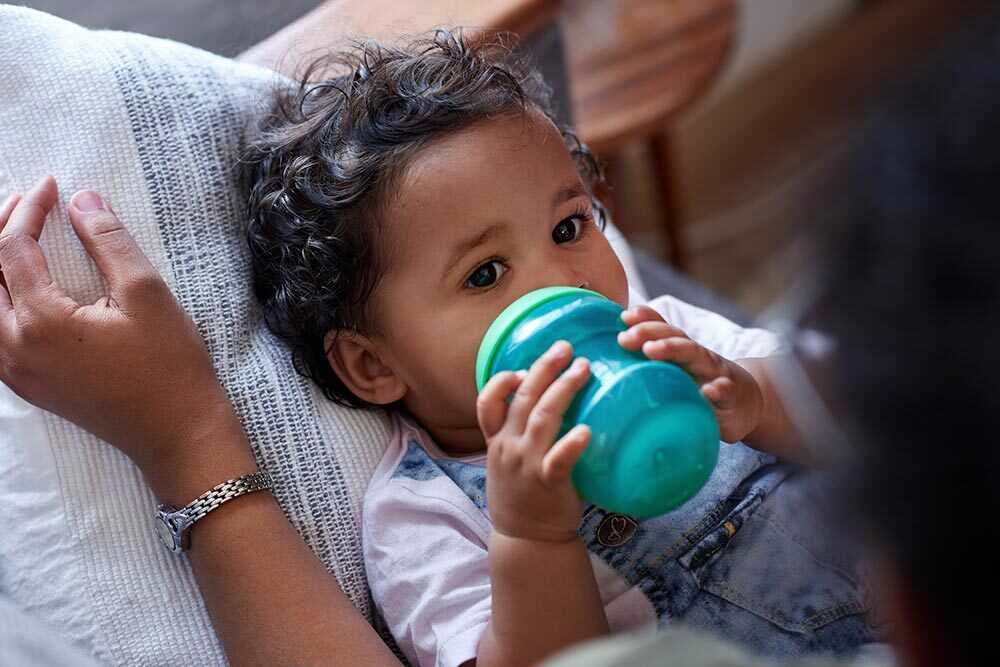How to Build a Baby Bedtime Routine That Actually Works

A baby bedtime routine that works isn’t about perfection but consistency, calm, and connection. With a few repeatable steps and realistic expectations, you can turn chaos into comfort and help your baby (and yourself) get better rest.
Why a Baby Bedtime Routine Matters
Building a calm baby bedtime routine might feel laughable when you’re running on three hours of sleep and scavenging granola crumbs off the floor. But hear us out: a predictable nighttime rhythm isn’t just good for your baby—it’s a game-changer for you, too.
A consistent routine helps reset your baby’s internal clock and sends a clear signal to their brain: it’s time to wind down.Even more, it builds trust and emotional closeness—something no gadget or glow-up bassinet can replicate.
Your baby’s sleep schedule doesn’t need to be perfect. But it does need to be predictable.
Benefits of a Solid Bedtime Routine:
- Your baby will fall asleep more quickly and maintain sleep longer through a consistent bedtime routine.
- Creating a soothing bedtime routine for your baby doesn’t require complex steps.
- Your baby’s sleep schedule needs steady repetition and calming elements that work within your real-life constraints.
- A consistent baby bedtime routine functions beyond nighttime solutions by building healthy sleep patterns which support infant development and provide body comfort while improving rest for everyone at home.
But let’s be real. The combination of cluster feedings with diaper changes and unexpected midnight dance parties turns bedtime into a hectic experience instead of a peaceful one.
This guide delivers real-world tips to establish a nightly bedtime routine that supports young children with predictable and nurturing practices that work.
Start with the Science
The establishment of a routine is important because babies who are younger than six months do best when they experience consistent patterns.
- Predictable sleep patterns establish their circadian rhythm, which acts as their internal body clock to signal sleep and wake times.
- Children learn to expect sleep when they follow a regular bedtime routine, which helps them settle down faster and creates more consistent sleeping patterns.
- A consistent sleep routine assists with sleep initiation while also enhancing the duration and quality of nighttime rest.
A warm bath and lullaby play their roles but they are not the sole elements of an effective bedtime routine. A structured bedtime routine delivers clear cues that it’s time to start relaxing.
Your Evening Roadmap: An Effective Bedtime Routine
Follow along with us through an effective bedtime routine that promotes both safe sleep practices and peaceful nights.
1. Watch the Clock
The timing aspect of baby care holds more importance than many parents understand. It is crucial to monitor wake windows because they represent the time your baby can stay awake between naps without becoming fussy.
- If you extend the awake window too long your baby will become overtired.
- When babies become overtired their transition to sleep becomes difficult and they become fussy.
The duration of your baby’s awake time will gradually extend as they grow:
- Newborns need their bedtime routine after only 45 minutes of wakefulness
- Older babies can handle longer awake periods
Pay attention to your baby’s sleep cues:
- Rubbing their eyes
- Zoning out
- Showing sudden crankiness
These are signs to begin the wind-down routine.
2. Create a Calm Environment
- Dim the lights.
- Lower the noise.
- Reduce stimulation.
The nighttime atmosphere for your baby holds significant importance in establishing their sleep routine.
- White noise helps block household sounds to establish a steady auditory environment.
- Check that their sleep sack or swaddle remains cozy yet loose for babies who haven’t started rolling.
- For nighttime sleep to be successful it is essential to keep body temperature neither too hot nor too cold.
Begin reading bedtime stories at this time even if they don’t understand yet. The soothing pattern of your voice combined with gentle repetition indicates to your baby that relaxation time has begun.
3. Bath Time and Bonding
A warm bath serves multiple purposes beyond basic hygiene. The drop in your baby’s core body temperature after a warm bath promotes sleepiness.
- Many families consider bath time as their initial significant step toward the nightly bedtime routine.
- Apply a gentle baby lotion to your child after their bath to perform a soothing massage.
This activity:
- Extends beyond skincare
- Creates a bonding moment between parent and baby
- Helps baby feel safe and calm through cuddles, soft snuggles and eye contact
- Assists them in easing into sleep
4. Feed, Change, Cuddle
Once your baby has finished their bath and massage session the final feeding time begins.
- This feeding stage stands out as a vital step in your baby’s bedtime routine whether you choose breastfeeding or bottle-feeding.
- A baby with a full stomach tends to sleep longer during the night which also helps them stay asleep until morning.
Follow feeding with:
- A quick diaper change to prevent wetness from waking them
- Dim lighting and quiet interactions
Play a lullaby or gentle hum during feeding to signal that bedtime is approaching.
5. Lay Them Down Drowsy—But Awake
Though opinions differ on this method, teaching your baby to self-soothe helps develop lasting sleep assurance.
- Your objective should be to help your baby learn to fall asleep on their own while providing comfort when necessary.
- Sleep consultants suggest putting babies into their cribs while they are relaxed and starting to doze but before they drift completely off to sleep.
- They learn to associate the crib with falling asleep rather than just waking up.
Note: It’s okay if this takes practice. The transition to independent sleep for babies often requires time because sleep regressions can complicate the process.
Progress over perfection.
Don’t Forget About Naps
Naps serve as an essential foundation for establishing good nighttime sleep patterns.
- The naptime routine should remain consistent but be a condensed version of your bedtime routine.
- A predictable daily schedule supports maintaining consistent sleep patterns.
Examine the structure of your baby’s awake periods when they experience naptime difficulties.
Allowing babies to stay awake too long between sleep periods poses challenges for falling asleep during naptime and bedtime.
Beyond the Routine
- Choose a sleep sack as a safe sleep option to eliminate SIDS risks instead of using a blanket.
- Begin reading bedtime stories to your baby as soon as possible even though they may chew on the book instead of listening.
- Establish a consistent bedtime schedule throughout the week including weekends to foster healthy sleep patterns.
- Avoid overstimulating play right before bedtime.
- Use lullabies, not screens, to wind down.
- Consult with your pediatrician before implementing any new sleep training strategies.
- Expect changes. Sleep regressions occur naturally while babies experience growth spurts or teething.
What If Your Baby Won’t Sleep?
You can follow all the guidelines perfectly but your baby may continue to have sleep difficulties.
- When your baby continues to struggle with sleep even after following proper guidelines, it may be necessary to seek assistance from a pediatrician or certified sleep consultant.
- They can evaluate your child’s sleeping patterns to determine if adjustments to your bedtime routine or sleep setting are necessary.
Also, trust your instincts:
- Some babies need more cuddles.
- Some need less stimulation.
- You know your child better than anyone.
Expert Sleep Recommendations
The American Academy of Pediatrics advises parents to establish a regular nighttime routine which contributes to proper sleep hygiene.
They also emphasize the importance of safe sleep practices:
- Position your baby on their back
- Ensure they sleep on a firm mattress
- Avoid loose bedding
Parents can promote effective sleep for all family members by establishing bedtime routines because sleep patterns develop during early childhood. This approach lowers stress levels while establishing dependable patterns which help both parent and infant gain confidence.
Final Thoughts
A baby bedtime routine isn’t about perfection—it’s about rhythm, reassurance, and repetition. It’s the quiet pattern that helps your little one feel safe, and helps you both ease into rest.
Consistency is what teaches babies that sleep is coming next. Comfort is what makes them welcome it. Over time, those small, repeated steps—white noise humming, soft pajamas, a gentle feed, a familiar story—become powerful cues that signal safety and sleep.
And while no two nights will ever look exactly the same, the habit of winding down together becomes something you both rely on. Not because it’s flawless. But because it’s familiar. And yours.








